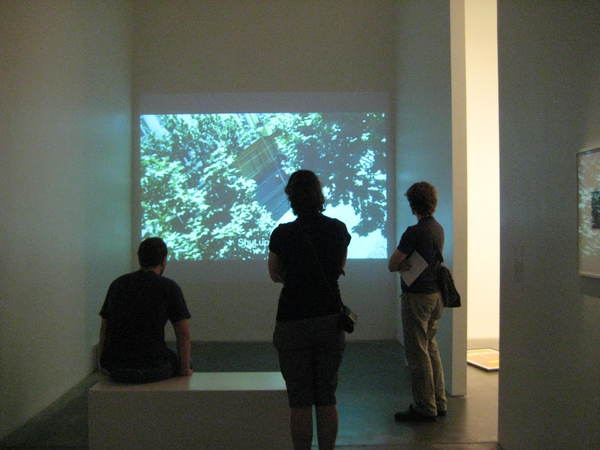The recent shifting in the curatorial make up of Boston has caused me to stop and reflect upon just what these institutions actually mean to us. With curators moving from one museum to another or an academic institution to a museum does this reflect upon what that institution represents? Or does it change the way we think of that particular museum? I ask because as artists and people involved in the local arts community we often feel a sense of ownership. It is our museum and our art. Meanwhile we all know that this isn’t true. It is not ours much like Bank of America isn’t our bank. These are institutions that have created this sense of ownership as much for their own survival as for marketing purposes.
We are emotionally invested in our cultural spaces. There is a special feeling you get when you walk through your favourite gallery or sit in the balcony of Symphony Hall. These spaces are created to have this effect. You enter into them and everything from the lighting to the wall colours to the audio (or lack thereof) all merge to create a transformative experience. It is the effect of the space and the art together that cause us to either love or hate an experience. Which is why a poorly installed or poorly thought-out exhibition can often cause one to recoil or leave dismayed. But one that is well done and engaging can leave you reflecting for days. Art can be transporting and transforming (one of the main reasons I personally am so invested in it). The spaces that present and hold that art can and should occupy a place in our culture. This is one of the main reasons that museums were founded.
In the late 19th century art was seen as a means of uplifting and educating the public. Both the Metropolitan Museum of Art in New York and the Museum of Fine Arts in Boston (created within a year or two of each other) were brought into being by wealthy art collectors who believed (in their post-enlightenment haze) that the general public needed exposure to the arts. It is really at the core of their meaning. These institutions would serve as repositories for all the arts of humankind in order for us “little” people to have a greater understanding of the human experience. One would be able to see the creation of art throughout history and walk away a little wiser. But behind this desire to educate lay another motivation, one decidedly less altruistic. These institutions would also serve as reminders of who these people were. Would we remember Andrew Carnegie without Carnegie Hall? These buildings and their holdings are markers of who gave what. Now, this is true about many institutions from civic constructs to academic institutions (Duke University anyone?) so I am not going over this as a criticism. Where would we be without these people and their donations? It is thanks to them that many of these organizations still survive. I simply want to illustrate that the idea that these institutions belong to us is really a culturally constructed illusion, because in reality they don’t.
Despite being a member of an institution you really don’t have a say in how it is run or operated. You can buy all the memberships you want and it doesn’t give you access to the director’s office. If anyone has this ability it is because they have given lots of money. And yet does giving lots of money actually give that person gain ownership? They can certainly take their money and their artwork someplace else but when given it is no longer theirs. You could say that the institution owns the institution. Today these organizations are complex systems involving hundreds of people tied up in a bureaucratic structure that actually (if properly run) will outlast many of us. The only person who can guide this structure is the director. Who is, of course, beholden to the Trustees. In this regard there is little difference between large cultural institutions and corporations. These institutions are large corporations. With the difference being one is beholden to shareholders and the other to trustees, and one is designed to return a profit and the other isn’t (well, there is no dividend given by cultural non-profits so the desire to return one usually stems from a need for solvency). But at the end of the day it is the director of the museum who bears responsibility for how that institution behaves.
When we talk about who puts on what show where and get upset when someone leaves or is hired it shows our emotional investment. So, we feel that we have a right to bitch and moan when something is done in a manner that we don’t approve of. It can be depressing to think about but at the end of the day the institution will continue doing what it wants. There is no survey of what its audience wants to see. When done correctly the museum will act intellectually and thoughtfully about what it presents to the public. An institution can be lead by scholarship and cultural integrity in the manner of Philippe de Montebello, who led the Metropolitan Museum of Art for 30 years. Or one can decide to orient the museum towards more populist fare. Can there be a happy medium? I’d like to think so. There is nothing wrong with large bombastic exhibitions. The recent Titian exhibit at the MFA, Boston was one of the most amazing shows I have seen in a long time. These “cash cow” shows are often interesting, occasionally insipid, but also very necessary. The money generated by such a show enables an institution to purchase more art or perhaps put on an exhibition that is geared to a more finite group of people. Alas, the fine line between the high and the low art is rarely walked. Why? Because it is harder to do and requires an ability to envision the big picture.
One has to have the sense of what the museum can be outside of one’s own prejudices or preferences. The leader of the museum needs to think about what the role of that museum is in his/her particular time and culture. One can’t simply guide a large, meaningful organization – like a museum – based upon one’s own predilection for a particular time and art form. Do they? Of course they do. At the end of the day the museum director is the one who steers that ship. And their management style and personal taste will dictate how that institution is run. We can complain and critique (thankfully) all the while hoping for the best. At the end of our day we want them to be really, really good at their jobs and give us the best. Will they always succeed? Not at all. But even the best of them put on shitty shows occasionally. There are missteps and blunders. They are, after all, institutions run by humans. And being humans, we sometimes make bad decisions. As I write this I am drinking far too much coffee. Bad decision on my part? Probably. Will I stop? No. So I am stepping back from the brouhaha of musical curatorial chairs. I am going to think positive. Do I think that from a business perspective some bad decisions were made? Yes. Am I going to be hopeful that something good comes of it? Maybe. I do delight in a bit of schadenfreude. Actually, I take that back. I am hopeful. I want some good to come of this change. I really, really hope it does. Time will tell.




